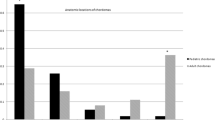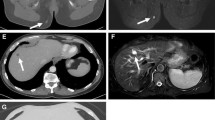Abstract
Chordomas are malignant tumors derived from remnants of the notochord. These are extremely rare in pediatric patients, accounting for approximately 5% of all chordomas, with most lesions occupying the cranium. Chordomas also can occupy all levels of the spine, demonstrating a broad spectrum of neurologic presentation. Optimal treatment aims for gross total resection with accompanying radiation therapy to prevent recurrence. Their aggressive and infiltrative nature makes clinical management challenging, involving multiple disciplines and close monitoring to ensure optimal outcomes. This comprehensive review aims to cover the genetics, demographics, pathogenesis, neurologic sequelae, radiological considerations, chemotherapeutic management, surgical management, and post-operative considerations of pediatric chordoma patients.

Similar content being viewed by others
Data availability
Not applicable.
Code availability
Not applicable.
References
Bailey P, Bagdasar D (1929) Intracranial chordoblastoma. Am J Pathol 5:439–450 (PMID: 19969867; PMCID: PMC2003507)
Argaud R, Lestrade A (1926) Sur la précocité de certains chordomes sacrococcygiens. Bull Acad de méd 95:375–377
Occhipinti E, Mastrostefano R, Pompili A et al (1981) Spinal chordomas in infancy. Report of a case and analysis of the literature. Childs Brain 8(3):198–206 (PMID: 7238137)
Rassi MS, Hulou MM, Almefty K et al (2018) Pediatric clival chordoma: a curable disease that conforms to collins’ law. Neurosurgery 82(5):652–660. https://doi.org/10.1093/neuros/nyx254 (PMID: 28521059)
Smoll N, Gautschi O, Radovanovic I et al (2013) Incidence and relative survival of chordomas: the standardized mortality ratio and the impact of chordomas on a population. Cancer 119(11):2029–2037. https://doi.org/10.1002/cncr.28032 (Epub 2013 Mar 15 PMID: 23504991)
Borba L, Al-Mefty O, Mrak R et al (1996) Cranial chordomas in children and adolescents. J Neurosurg 84(4):584–591. https://doi.org/10.3171/jns.1996.84.4.0584 (PMID: 8613849)
Bai J, Zhang S, Zhai Y et al (2020) A series of 62 skull base chordomas in pediatric and adolescent patients: clinical characteristics, treatments, and outcomes. Neurol India 68(5):1030–1036. https://doi.org/10.4103/0028-3886.294548 (PMID: 33109847)
Beccaria K, Sainte-Rose C, Zerah M et al (2015) Paediatric chordomas. Orphanet J Rare Dis 22(10):116. https://doi.org/10.1186/s13023-015-0340-8 (PMID:26391590;PMCID:PMC4578760)
Choi G, Yang M, Yoon D et al (2010) Pediatric cervical chordoma: report of two cases and a review of the current literature. Childs Nerv Syst 26(6):835–840. https://doi.org/10.1007/s00381-009-1076-3 (Epub 2010 Jan 22 PMID: 20094721)
Page MJ, Moher D, Bossuyt PM, et al. (2021) PRISMA 2020 explanation and elaboration: updated guidance and exemplars for reporting systematic reviews. bmj. 372
Das P, Soni P, Jones J et al (2020) Descriptive epidemiology of chordomas in the United States. J Neurooncol 148(1):173–178. https://doi.org/10.1007/s11060-020-03511-x (Epub 2020 Apr 28 PMID: 32342333)
Cates JM. Chordoma [Internet] (2017) https://rarediseases.org/rare-diseases/chordoma/. (Accessed 28 Feb 2021).
Wasserman JK, Gravel D, Purgina B (2018) Chordoma of the head and neck: a review. Head Neck Pathol 12(2):261–268. https://doi.org/10.1007/s12105-017-0860-8
Gröschel S, Hübschmann D, Raimondi F et al (2019) Defective homologous recombination DNA repair as therapeutic target in advanced chordoma. Nat Commun 10(1):1635. https://doi.org/10.1038/s41467-019-09633-9.PMID:30967556;PMCID:PMC6456501
Sharifnia T, Wawer MJ, Chen T et al (2019) Small-molecule targeting of brachyury transcription factor addiction in chordoma. Nat Med 25(2):292–300. https://doi.org/10.1038/s41591-018-0312-3 (Epub 2019 Jan 21. PMID: 30664779; PMCID: PMC6633917)
Gulluoglu S, Turksoy O, Kuskucu A, Ture U, Bayrak OF (2016) The molecular aspects of chordoma. Neurosurg Rev 39(2):185–196. https://doi.org/10.1007/s10143-015-0663-x (Epub 2015 Sep 12. PMID: 26363792)
de Bree K, de Bakker BS, Oostra RJ (2018) The development of the human notochord. PLoS ONE 13(10):e0205752. https://doi.org/10.1371/journal.pone.0205752 (PMID:30346967;PMCID:PMC6197658)
Stratt B, Steiner RM (1980) The radiologic findings in posterior mediastinal chordoma. Skeletal Radiol 5(3):171–173. https://doi.org/10.1007/BF00347259 (PMID: 7209569)
Vujovic S, Henderson S, Presneau N et al (2006) Brachyury, a crucial regulator of notochordal development, is a novel biomarker for chordomas. J Pathol 209(2):157–165. https://doi.org/10.1002/path.1969 (PMID: 16538613)
Ramesh T, Nagula SV, Tardieu GG et al (2017) Update on the notochord including its embryology, molecular development, and pathology: a primer for the clinician. Cureus 9(4):e1137. https://doi.org/10.7759/cureus.1137 (PMID:28480155;PMCID:PMC5418029)
Heaton JM, Turner DR (1985) Reflections on notochordal differentiation arising from a study of chordomas. Histopathology 9(5):543–550. https://doi.org/10.1111/j.1365-2559.1985.tb02835.x (PMID: 4007792)
Sebro R, DeLaney T, Hornicek F et al (2016) Differences in sex distribution, anatomic location and MR imaging appearance of pediatric compared to adult chordomas. BMC Med Imaging 16(1):53
Lau CS, Mahendraraj K, Ward A et al (2016) Pediatric chordomas: a population-based clinical outcome study involving 86 patients from the surveillance, epidemiology, and end result (SEER) database (1973–2011). Pediatr Neurosurg 51(3):127–136 (Epub 2016 Feb 17. doi: 10.1159/000442990. Epub 2016 Feb 17. PMID: 26881831)
Shih AR, Cote GM, Chebib I et al (2018) Clinicopathologic characteristics of poorly differentiated chordoma. Mod Pathol 31(8):1237–1245. https://doi.org/10.1038/s41379-018-0002-1 (Epub 2018 Feb 26. Epub 2018 Feb 26. PMID: 29483606)
Hofmann E (2012) The clivus: anatomy, normal variants and imaging pathology. Clin Neuroradiol 22(2):123–139. https://doi.org/10.1007/s00062-011-0083-4 (Epub 2011 Jun 28. PMID: 21710384)
Wold LE, Laws ER Jr (1983) Cranial chordomas in children and young adults. J Neurosurg 59(6):1043–1047. https://doi.org/10.3171/jns.1983.59.6.1043 (PMID: 6631498)
Wang L, Wu Z, Tian K et al (2017) Clinical features and surgical outcomes of patients with skull base chordoma: a retrospective analysis of 238 patients. J Neurosurg 127(6):1257–1267. https://doi.org/10.3171/2016.9.JNS16559 (Epub 2017 Jan 6 PMID: 28059654)
Brooks M, Kleefield J, O’Reilly GV et al (1987) Thoracic chordoma with unusual radiographic features. Comput Radiol 11(2):85–90. https://doi.org/10.1016/0730-4862(87)90016-3 (PMID: 3608452)
Kozlowski K, Barylak A, Campbell J et al (1990) Primary sacral bone tumours in children (report of 16 cases with a short literature review). Australas Radiol 34(2):142–149. https://doi.org/10.1111/j.1440-1673.1990.tb02830.x (PMID: 2241666)
Hamilton K, Rebsamen S, Salamat S et al (2019) Pediatric extraosseous sacral chordoma: case report and literature review of embryonic derivation and clinical implications. J Neurosurg Pediatr 22:1–6. https://doi.org/10.3171/2018.12.PEDS18544 (Epub ahead of print. PMID: 30797212)
Richards AT, Stricke L, Spitz L (1973) Sacrococcygeal chordomas in children. J Pediatr Surg 8(6):911–914. https://doi.org/10.1016/0022-3468(73)90010-9 (PMID: 4785565)
Agunbiade S, Nada A, Bhimaniya S et al (2020) Chordoma with lung metastases at initial presentation of a pediatric patient. Radiol Case Rep 15(4):382–386. https://doi.org/10.1016/j.radcr.2020.01.004 (PMID:32055265;PMCID:PMC7005512)
Joyce EJ, Cohen MA, Ho W et al (2020) Extreme lateral transodontoid approach for resection of clival chordoma: 2-dimensional operative video. Oper Neurosurg (Hagerstown) 19(3):E298. https://doi.org/10.1093/ons/opz411 (PMID: 31943094)
Frankl J, Grotepas C, Stea B et al (2016) Chordoma dedifferentiation after proton beam therapy: a case report and review of the literature. J Med Case Rep 10(1):280. https://doi.org/10.1186/s13256-016-1076-3 (PMID:27729085;PMCID:PMC5059891)
Habrand JL, Datchary J, Bolle S et al (2016) Chordoma in children: case-report and review of literature. Rep Pract Oncol Radiother 21(1):1–7. https://doi.org/10.1016/j.rpor.2015.10.007 (PMID: 26900351; PMCID: PMC4716407)
Miyahara H, Nodomi S, Umeda K et al (2020) Chemoradiotherapy for unresectable INI1-negative chordoma in a child. J Pediatr Hematol Oncol 42(1):65–68. https://doi.org/10.1097/MPH.0000000000001318 (PMID: 30281526)
Baliga S, Yock TI (2019) Proton beam therapy in pediatric oncology. Curr Opin Pediatr 31(1):28–34. https://doi.org/10.1097/MOP.0000000000000724 (PMID: 30531222)
Mizumoto M, Oshiro Y, Yamamoto T et al (2017) Proton beam therapy for pediatric brain tumor. Neurol Med Chir (Tokyo) 57(7):343–355. https://doi.org/10.2176/nmc.ra.2017-0003 (PMID: 28603224; PMCID: PMC5566707)
Di Maio S, Temkin N, Ramanathan D et al (2011) Current comprehensive management of cranial base chordomas: 10-year meta-analysis of observational studies. J Neurosurg 115(6):1094–1105. https://doi.org/10.3171/2011.7.JNS11355 (Epub 2011 Aug 5 PMID: 21819197)
Ahrendt MN, Wesselhoeft CW (1992) Chordoma presenting as a posterior mediastinal mass in a pediatric patient. J Pediatr Surg 27(12):1515–1518. https://doi.org/10.1016/0022-3468(92)90489-t (PMID: 1469556)
Tao ZZ, Chen SM, Liu JF et al (2005) Paranasal sinuses chordoma in pediatric patient: a case report and literature review. Int J Pediatr Otorhinolaryngol 69(10):1415–1418. https://doi.org/10.1016/j.ijporl.2005.03.027 (PMID: 15913796)
McDowell MM, Zwagerman NT, Wang EW et al (2020) Long-term outcomes in the treatment of pediatric skull base chordomas in the endoscopic endonasal era. J Neurosurg Pediatr 20:1–10. https://doi.org/10.3171/2020.6.PEDS19733 (Epub ahead of print. PMID: 33254137)
Bianchi PM, Marsella P, Masi R et al (1989) Cervical chordoma in childhood: clinical statistical contribution. Int J Pediatr Otorhinolaryngol 18(1):39–45. https://doi.org/10.1016/0165-5876(89)90229-2 (PMID: 2807753)
Soudack M, Guralnik L, Ben-Nun A et al (2007) Imaging features of posterior mediastinal chordoma in a child. Pediatr Radiol 37(5):492–497. https://doi.org/10.1007/s00247-007-0420-6 (Epub 2007 Mar 8 PMID: 17345078)
Castellano GC, Johnston HW (1975) Intrathoracic chordoma presenting as a posterior mediastinal tumor. South Med J 68(1):109–112. https://doi.org/10.1097/00007611-197501000-00029 (PMID: 1154050)
Selvaraj A, Wood AJ (2003) Superior mediastinal chordoma presenting as a bilobed paravertebral mass. Eur J Cardiothorac Surg 23(2):248–250. https://doi.org/10.1016/s1010-7940(02)00753-4 (PMID: 12559357)
Chau L, Malicki DM, Levy ML et al (2020) Unusual extradural chordoma in an adolescent presenting with lumbar radiculopathy. BMJ Case Rep 13(4):e234942. https://doi.org/10.1136/bcr-2020-234942 (PMID:32265215;PMCID:PMC7244276)
Al-Adra D, Bennett A, Gill R, Lees G (2011) Pediatric metastatic sacrococcygeal chordoma treated with surgery. Eur J Pediatr Surg 21(3):196–198. https://doi.org/10.1055/s-0031-1271635 (Epub 2011 Feb 21 PMID: 21341180)
Chandawarkar RY (1996) Sacrococcygeal chordoma: review of 50 consecutive patients. World J Surg 20(6):717–719. https://doi.org/10.1007/s002689900110 (PMID: 8662159)
Stapleton AL, Tyler-Kabara EC, Gardner PA et al (2017) Risk factors for cerebrospinal fluid leak in pediatric patients undergoing endoscopic endonasal skull base surgery. Int J Pediatr Otorhinolaryngol 93:163–166. https://doi.org/10.1016/j.ijporl.2016.12.019 (Epub 2016 Dec 26 PMID: 28109490)
Soudry E, Turner JH, Nayak JV et al (2014) Endoscopic reconstruction of surgically created skull base defects: a systematic review. Otolaryngol Head Neck Surg 150(5):730–738. https://doi.org/10.1177/0194599814520685 (Epub 2014 Feb 3 PMID: 24493791)
Hussein K, Bitterman R, Shofty B et al (2017) Management of post-neurosurgical meningitis: narrative review. Clin Microbiol Infect 23(9):621–628. https://doi.org/10.1016/j.cmi.2017.05.013 (Epub 2017 May 18 PMID: 28529027)
Dashti SR, Baharvahdat H, Spetzler RF et al (2008) Operative intracranial infection following craniotomy. Neurosurg Focus 24(6):E10. https://doi.org/10.3171/FOC/2008/24/6/E10 (PMID: 18518740)
Owens CD, Stoessel K (2008) Surgical site infections: epidemiology, microbiology and prevention. J Hosp Infect 70(Suppl 2):3–10. https://doi.org/10.1016/S0195-6701(08)60017-1 (PMID: 19022115)
Moran D, Zadnik PL, Taylor T et al (2015) Maintenance of bowel, bladder, and motor functions after sacrectomy. Spine J 15(2):222–229. https://doi.org/10.1016/j.spinee.2014.08.445 (Epub 2014 Sep 6 PMID: 25195977)
Fourney DR, Rhines LD, Hentschel SJ et al (2005) En bloc resection of primary sacral tumors: classification of surgical approaches and outcome. J Neurosurg Spine 3(2):111–122. https://doi.org/10.3171/spi.2005.3.2.0111 (PMID: 16370300)
Koutourousiou M, Gardner PA, Tormenti MJ et al (2012) Endoscopic endonasal approach for resection of cranial base chordomas: outcomes and learning curve. Neurosurgery 71(3):614–624. https://doi.org/10.1227/NEU.0b013e31825ea3e0 (PMID: 22592328)
Taneja B, Srivastava V, Saxena KN (2012) Physiological and anaesthetic considerations for the preterm neonate undergoing surgery. J Neonatal Surg 1(1):14 (PMID: 26023373; PMCID: PMC4420318)
Edomwonyi NP, Ekwere IT, Egbekun R et al (2006) Anesthesia-related complications in children. Middle East J Anaesthesiol 18(5):915–927 (PMID: 17094529)
Funding
The authors have not received any funding for this work from any organization.
Author information
Authors and Affiliations
Contributions
TR was the author that initially presented the idea to the other coauthors. All authors shared equal contributions in material preparation, writing, editing, and review of final drafts prior to submission.
Corresponding author
Ethics declarations
Conflict of interest
The authors report no conflict of interest concerning the materials or methods used in this study or the findings specified in this paper.
Ethics approval
Not applicable.
Consent to participate
Not applicable.
Consent for publication
Not applicable.
Additional information
Publisher's Note
Springer Nature remains neutral with regard to jurisdictional claims in published maps and institutional affiliations.
Rights and permissions
About this article
Cite this article
Reardon, T., Marsh, C., Rippe, P. et al. Clinical management of pediatric chordomas: a comprehensive review. Acta Neurol Belg 121, 1407–1414 (2021). https://doi.org/10.1007/s13760-021-01821-z
Received:
Accepted:
Published:
Issue Date:
DOI: https://doi.org/10.1007/s13760-021-01821-z




